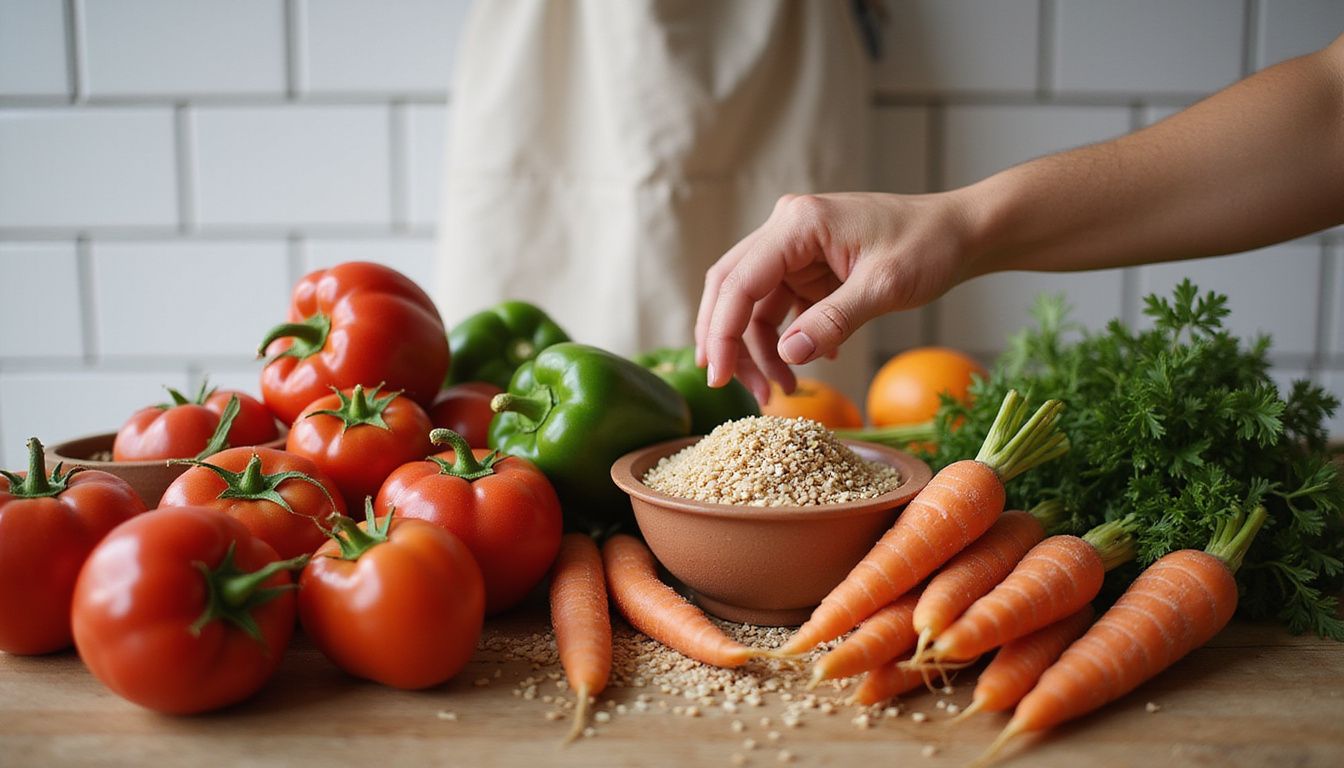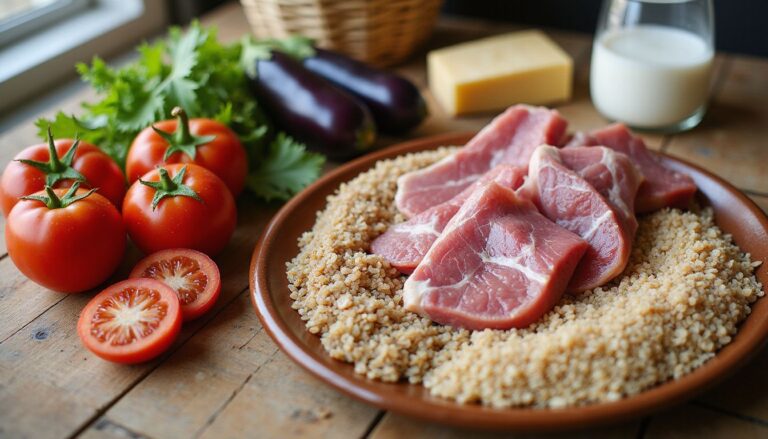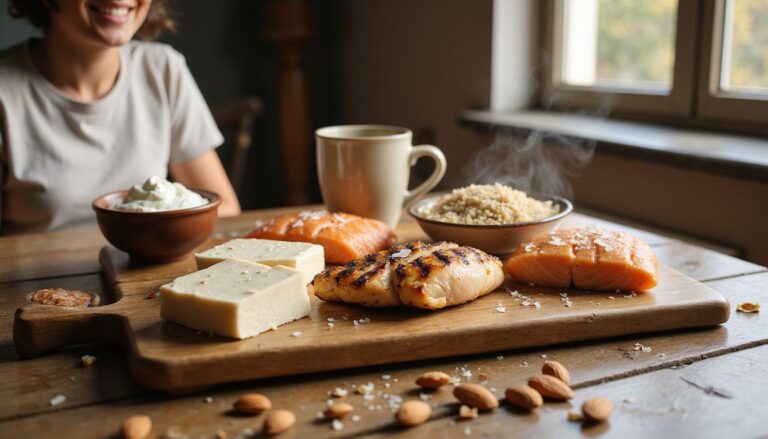7-Day Simple Meal Plan For Weight Loss: Free Diet Plan To Help You Lose Weight
Our Nutrition Assistant AI Suite will transform your body. You will lose fat, get toned, and build muscle. Gain confidence and optimal health.
Trying to lose weight without a clear plan can feel exhausting. A simple meal plan for weight loss gives you structure, saves time, and supports better health. Research shows that planned, balanced meals help people stick to a calorie target and build steady habits over time.
This guide shares a Simple Meal Plan To Lose Weight Free. You get clear meals for seven days, built around whole foods that are easy to prep and budget friendly. Follow along to refresh your eating habits and move closer to your goals.
Key Takeaways
- A 7-day structured meal plan with about 1,200 calories per day can support safe weight loss; adjust calories for your size, health, and activity level.
- Whole foods, such as lean proteins, whole grains, fruits, and vegetables, increase fullness and improve overall nutrition while keeping costs reasonable.
- The Mayo Clinic Diet reports members losing 6–10 pounds in two weeks, driven by a consistent calorie deficit, balanced macronutrients, and portion control.
- Meal prep, bulk buying, smart leftovers, and portion tracking reduce food waste, support consistency, and lower the chances of overeating.
- Experts like Stefani Sassos, M.S., R.D., C.D.N., note that clear structure makes healthy eating easier to repeat, which supports long-term weight management.
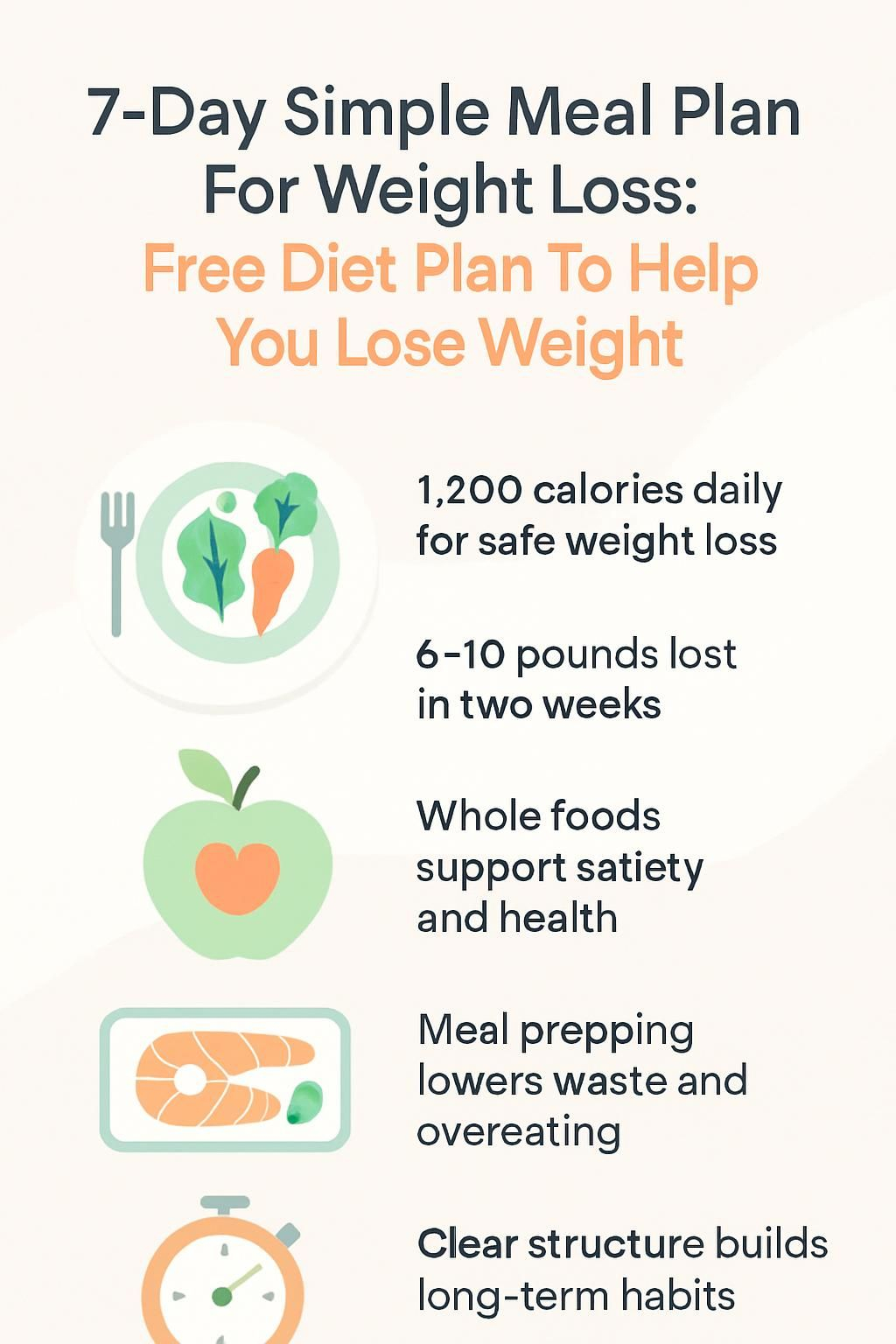
How can a 7-day meal plan support weight loss?
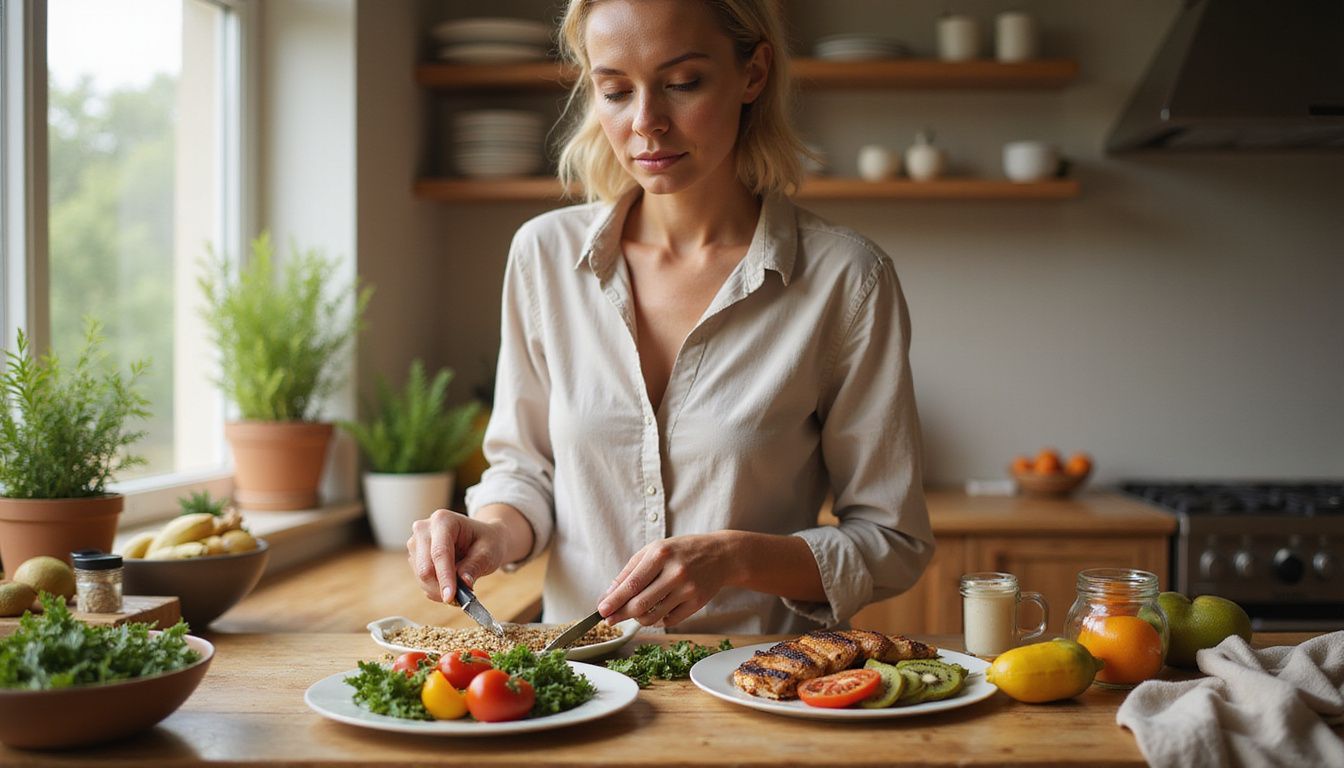
A 7-day plan creates a daily roadmap, so you are not guessing at every meal. “A structured plan can help develop healthier eating habits,” says Stefani Sassos, M.S., R.D., C.D.N., deputy nutrition director for the Good Housekeeping Institute.
This sample plan centers on about 1,200 calories per day. That level may suit some smaller or less active adults. Many people will need more, often 1,400 to 1,800 calories, to stay satisfied and support daily activity. Adjust the plan to your needs or speak with a registered dietitian for personalized guidance.
The plan does not promote skipping meals. You get breakfast, lunch, and dinner built around lean proteins, produce, and whole grains. Simple recipes keep shopping easy and costs low.
Tracking your meals teaches portion sizes and basic nutrition. Over one week, these small steps can start new habits that support steady, long-term progress.
Key principles of an effective weight loss meal plan
A smart plan follows a few clear rules. Use these basics to meet your nutritional needs while you lower calories in a safe way.
What is a calorie deficit and why does it matter?
A calorie deficit means you eat fewer calories than your body uses. Your body then turns to stored fat for energy, which helps reduce weight. A simple plan with clear meals and portions can make this easier to follow day after day.
Evidence shows that a calorie deficit is required for losing weight. Many people do well with a structured plan focused on whole foods and measured portions. Members of the Mayo Clinic Diet report losing 6–10 pounds in two weeks when they keep a steady deficit and stay consistent.
From my own time on a guided plan, steady progress felt doable without strict counting or complex cooking. Whole foods made it easier to feel satisfied on fewer calories.
How to balance macronutrients for weight loss
Macronutrients are protein, carbohydrates, and fats. Getting the right mix can help you lose fat while protecting muscle. Aim for lean protein at each meal, such as chicken, tuna, tofu, shrimp, or low-fat Greek yogurt.
Studies suggest that about 25 to 30 grams of protein per meal can increase fullness and help maintain muscle during weight loss. Choose whole grains like brown rice, oats, or quinoa for steady energy. Fill half your plate with fruits and vegetables to boost fiber, which supports fullness and gut health. Include small amounts of healthy fats, such as olive oil or a few almonds, for flavor and heart health.
I replaced refined bread with whole-wheat toast and added fruit at breakfast. The extra fiber helped me stay full until lunch.
Balancing your meals with lean proteins and plenty of veggies can make all the difference in sticking to your plan, says nutrition expert Dr. Lisa Young.
Next, learn how portion control ties your meals to safe calorie targets.
Why is portion control important for losing weight?
Portion control keeps your calorie intake in line with your goals. A simple plan uses measured servings, for example 3 ounces of turkey breast or 1 cup of steamed broccoli per meal.
Sticking to portions helps many plans land near 1,200 calories per day, or higher if you need it. This lowers the risk of overeating and keeps progress moving. In my kitchen, using measuring cups and a small kitchen scale helped me see quick changes without guesswork.
Research links portion control with lower risk of type 2 diabetes and heart disease. Knowing your portions removes uncertainty and makes daily choices easier.
Meal prep tips for weight loss success
Planning ahead makes healthy eating simpler on busy days. Small steps add up and help you stay consistent.
How do you plan your meals in advance?
Map out your week before you shop. A short plan saves time, money, and stress during the workweek.
- Write a complete shopping list for seven days, including smoothie basics like frozen berries, banana, and milk.
- Choose simple, whole foods such as eggs, chicken, tuna, beans, and plenty of vegetables to support your calorie target.
- Batch cook staples. Make brown rice or roast trays of vegetables like red bell peppers and sweet potatoes for several meals.
- Repurpose leftovers. Use salmon from dinner in a salad the next day to cut prep time and costs.
- Pre-portion snacks, for example three-fourths cup cottage cheese or a medium apple, for grab-and-go options.
- Set one weekly prep block to wash greens and slice cucumbers and carrots. Ready veggies make salads fast.
- Cook familiar recipes during busy weeks to avoid burnout.
- Swap items as needed. Strained yogurt can stand in for cottage cheese if the store is out.
- Use free apps or a calendar to schedule prep steps so you do not forget key tasks before day 1.
- Track what you enjoy and repeat winners like overnight oats or peanut butter toast in future weeks.
Last month I followed these steps during a packed school schedule and lost four pounds while feeling in control.
What are the benefits of buying in bulk and using leftovers?
Bulk buys and planned leftovers make your plan faster, cheaper, and less stressful.
- Buy grains, legumes, and frozen produce in large bags to lower cost per serving and reduce trips to the store.
- Staples like soybeans, chickpeas, and corn keep well and simplify weekly prep.
- Turn dinner leftovers into lunch to cut waste and shorten cook time.
- Reuse ingredients. Cooked chicken works in wraps, salads, or grain bowls with little extra effort.
- Freeze extra soup or stew so you have a healthy dinner on busy nights.
- Build meals from the same base. Roast veggies at dinner, then use them in a hummus wrap the next day.
- Buying in bulk nudges you toward whole foods and away from sugary, processed snacks.
- Fewer store runs free up time for movement and better sleep.
- Leftovers make portion control easier because you can pack exact amounts for the next meal.
- I often cook extra rice and chicken on Sunday. Weeknights feel smoother, and I am less tempted by takeout.
Why stick to simple, whole foods for weight loss?
Whole foods are nutrient dense and help you stay full on fewer calories. For example, oatmeal with berries is more filling than sugar-coated cereal, and it supports stable energy.
Simple foods keep grocery bills low and reduce added sugar and hidden calories. Basics like roasted tomatoes, leafy greens, and hard-boiled eggs make tracking portions easier. This approach turns healthy eating into a routine you can keep for the long run.
What does a 7-day simple meal plan look like?
Here is a full week of ideas that use everyday ingredients like berries, yogurt, tuna, spinach, brown rice, and broccoli. Adjust portions to fit your needs.
Day 1:
Start with budget-friendly meals that use whole foods and pantry staples.
- Breakfast: One half cup oats cooked, topped with sliced banana and a little cinnamon for fiber and warmth.
- Snack: One hard-boiled egg for protein and fullness.
- Lunch: Lean turkey on whole grain toast with carrot sticks and an orange.
- Dinner: Grilled chicken breast with 1 cup steamed broccoli and one half cup brown rice. Season with garlic, black pepper, and herbs.
- Daily calories land near 1,200 for many people. Increase portions if you are active or feel hungry.
- Prep a few hard-boiled eggs or roast extra chicken to save time later in the week.
- Drink water throughout the day. Staying hydrated can help curb false hunger.
- Focus on nutrient-rich staples such as whole grain bread, berries, broccoli, eggs, onions, and lean poultry.
- Keeping meals simple helped me avoid processed snacks, added sugars, and heavy dressings.
- Use a light drizzle of olive oil on vegetables, or try vinegar and black pepper for flavor with fewer calories.
What to eat for breakfast on Day 1?
Have three-fourths cup bran flakes with one sliced banana and 1 cup fat-free milk. You get whole grains, potassium, and protein to keep you full.
Prefer something warm? Try one half cup oatmeal with banana slices and a dash of cinnamon. Both choices support weight loss with fiber and smart portions.
What is a healthy lunch option for Day 1?
Fill a mini whole wheat pita with 3 ounces turkey breast, half a roasted red pepper, lettuce, 1 teaspoon mayo, and a little mustard. Add a part-skim mozzarella stick and two kiwis for balance.
This mix gives you lean protein and fiber to stay satisfied. If you want a change, make a whole grain turkey sandwich and add carrot sticks for crunch.
What dinner supports weight loss on Day 1?
Eat 4 ounces flounder with 1 cup cooked couscous and 1 cup steamed broccoli. The mix of lean protein, whole grains, and fiber helps you feel full on fewer calories.
End with a single-serve ice cream if you like a small sweet. If you do not eat fish, swap in grilled chicken with one half cup brown rice and broccoli. Keep portions steady and seasoning simple.
Day 2:
Day 2 continues with high fiber choices and lean protein. Keep water close and plan portions before you plate your food.
- Breakfast: Greek yogurt with a handful of mixed berries for protein and fiber.
- Snack: A small apple for crunch, hydration, and volume.
- Lunch: Lentil soup with a slice of whole grain bread for plant protein and iron.
- Snack: A few walnuts for healthy fats that support fullness.
- Dinner: Stir-fried tofu with colorful vegetables over cooked quinoa.
- Hydration goal: at least 8 cups of water across the day.
- Stay near 1,200 calories if appropriate. Increase portions if you are active.
- Use leftovers from dinner for a faster lunch tomorrow.
- Limit heavy condiments. A little mustard or salsa adds flavor with fewer calories.
- Measure spreads with a tablespoon to avoid portion creep.
- Protect your sleep. Good rest helps control cravings.
What to eat for breakfast on Day 2?
Blend 1 cup frozen berries, one half banana, and 8 ounces low-fat or fat-free milk into a smoothie. Add 1 or 2 hard-boiled eggs if you want more protein.
Or scoop Greek yogurt into a bowl and top with mixed berries. Both options are quick, filling, and support your calorie target.
What is a healthy lunch option for Day 2?
Have 1 cup vegetable soup for vitamins and fiber. Pair it with a bean or lentil veggie burger on whole grain toast or an English muffin.
Add 1 cup grapes for a sweet finish without a spike in calories. Making extra soup the night before can save time at lunch.
What dinner supports weight loss on Day 2?
Barbecue cutlets with citrus slaw offer a satisfying, light dinner at about 265 calories per serving. The lean protein and fiber-rich slaw help control hunger and support steady blood sugar.
Another strong pick is sautéed spinach with garlic and olive oil, tomatoes, and half a baked potato. If you prefer plant-based, try tofu stir-fry over quinoa. These meals also fit later in the week when you want variety.
Day 3:
Day 3 keeps things balanced and simple. A bit of prep today can ease the rest of the week.
- Breakfast: Spinach, banana, and almond milk smoothie for vitamins and fiber.
- Snack: One fourth cup almonds for healthy fats and crunch.
- Lunch: Tuna salad with lettuce, tomato, and cucumber for lean protein.
- Dinner: Baked salmon with sweet potatoes and green beans for protein, complex carbs, and minerals.
- Aim for about 1,200 calories, adjusting portions to your needs.
- Save extra salmon or veggies for Day 4 lunches.
- Tuna and salmon are nutritious proteins that also fit many budgets.
Next, see breakfast ideas that set up your Day 3.
What to eat for breakfast on Day 3?
Cook one half cup quick oats with low-fat or unsweetened soy milk. Top with half a sliced apple, 1 teaspoon honey, and a sprinkle of cinnamon. You get fiber and slow-digesting carbs for steady energy.
Another choice is a spinach, banana, and almond milk smoothie. Both support weight loss and are easy on busy mornings.
What is a healthy lunch option for Day 3?
Make chicken salad with 4 ounces roast chicken, one fourth cup sliced red grapes, 1 tablespoon slivered almonds, and one fourth cup chopped celery. Mix 1 tablespoon mayo with 1 tablespoon Greek yogurt for a lighter dressing. Serve on crisp lettuce with one slice multigrain toast.
Or switch to tuna salad with lettuce, tomato, and cucumber. Both options offer lean protein to support muscle during weight loss.
What dinner supports weight loss on Day 3?
Serve 4 ounces steamed shrimp with a baked potato, 3 tablespoons salsa, and 1 tablespoon Greek yogurt. Add 3 cups steamed spinach on the side. For dessert, choose 1 ounce of dark chocolate or a 100 to 150 calorie ice cream bar.
This mix delivers protein, fiber, and volume without pushing calories too high. For variety, swap baked salmon for shrimp and pair it with sweet potatoes and green beans.
Day 4:
Day 4 focuses on lean protein, vegetables, and simple flavors. Leftovers continue to save time and money.
- Breakfast: Scrambled eggs with sautéed spinach. Two eggs provide about 12 grams of protein.
- Snack: Carrot sticks with 2 tablespoons hummus for plant protein and healthy fats.
- Lunch: Chickpea salad over mixed greens with vinaigrette for fiber and antioxidants.
- Dinner: Turkey meatballs with whole wheat spaghetti and marinara for protein and complex carbs.
- Pick whole foods at each meal. Fresh fruit like pineapple makes an easy dessert.
- Plan to reuse leftovers for quick meals later in the week.
- Drink water throughout the day to support appetite control and metabolism.
Prepping these meals ahead of time makes weekday choices easier. It also reduces last-minute snacking during hectic days.
What to eat for breakfast on Day 4?
Cook two scrambled eggs with sautéed spinach. Eggs supply protein that supports fullness. Spinach brings fiber, iron, and vitamins A and C.
Add black pepper or a pinch of paprika for extra flavor without many calories.
What is a healthy lunch option for Day 4?
Pour 1 cup tomato soup to start. Then make a mini whole wheat pita with 3 ounces roast beef, 1 teaspoon horseradish, a little mustard, tomato, and lettuce. Add 2 cups raw vegetables, such as carrots, cucumbers, and bell peppers, with one fourth cup hummus.
Or choose a chickpea salad over greens with a tangy vinaigrette. This lunch keeps you full for hours with protein and fiber.
What dinner supports weight loss on Day 4?
Have 4 ounces poached salmon with a crisp slaw made from 1.25 cups coleslaw mix, 2 chopped scallions, 1 tablespoon rice vinegar, and 1.5 teaspoons olive oil. Add 1 cup quinoa for a hearty whole grain.
If you want a swap, turkey meatballs with whole wheat spaghetti and marinara also fit well. Both dinners offer nutrients that support your goals.
Day 5:
Day 5 keeps meals easy, flavorful, and close to your calorie target.
- Breakfast: Whole grain toast with peanut butter and sliced banana for energy and fiber.
- Snack: A small orange for vitamin C and hydration.
- Lunch: Quinoa bowl with black beans, corn, and tomatoes for plant protein and fiber.
- Dinner: Balsamic-glazed pork tenderloin with roasted butternut squash.
- Stay near 1,200 calories if appropriate, or scale up with extra vegetables and lean protein.
- Use common supermarket staples to simplify shopping.
- Prep extra portions to cover tomorrow’s meals.
- Simple meals like these help manage hunger and support consistency.
- Drink water at each meal to support fullness.
What to eat for breakfast on Day 5?
Combine 1 cup Cheerios with 6 ounces plain Greek yogurt. Top with one half cup fresh berries and 1 tablespoon slivered almonds. This breakfast offers whole grains, protein, fiber, and healthy fats under 350 calories.
Or choose whole grain toast with peanut butter and banana slices for a warm option.
What is a healthy lunch option for Day 5?
Make mushroom quesadillas and serve with cucumber spears. Add one half cup 2 percent cottage cheese or Greek yogurt for extra protein. Include two clementines for natural sweetness and vitamin C.
Or prepare a quinoa bowl with black beans, corn, and tomatoes. These meals support fullness and steady energy.
What dinner supports weight loss on Day 5?
Balsamic-glazed pork tenderloin sits at about 370 calories per serving and supplies lean protein. Pair with roasted butternut squash for fiber, vitamins A and C, and a lightly sweet taste.
This combination kept me satisfied through the evening while keeping calories reasonable.
Day 6:
Day 6 highlights quick prep and high-satiety foods. Keep portions clear and use leftovers to cut cook time.
- Breakfast: One 100 percent whole-grain frozen waffle with 2 tablespoons nut butter and one small banana, plus 8 ounces fat-free milk.
- Snack: One boiled egg for high-quality protein.
- Lunch: Tuna salad with 10 baby carrots, two thirds cup plain Greek yogurt, and a small pear.
- Dinner: Spicy sausage jambalaya with 3 cups spinach sautéed in garlic and 1 tablespoon olive oil.
- Plan to reuse lunch or dinner leftovers tomorrow.
- Buy staples in bulk to save money and keep healthy foods on hand.
- Drink water throughout the day to support appetite control.
- Focus on fruits, vegetables, whole grains, and lean proteins for steady energy.
What to eat for breakfast on Day 6?
Toast a whole-grain frozen waffle. Spread 2 tablespoons nut butter, top with a sliced small banana, and sprinkle cinnamon and nutmeg. Drink 8 ounces fat-free milk.
The fiber, protein, and potassium kept me full during busy mornings.
What is a healthy lunch option for Day 6?
Tuna salad offers about 135 calories per serving and supports a calorie deficit. Add 10 baby carrots for fiber and crunch. Pair with two thirds cup plain Greek yogurt and a small pear for protein and natural sweetness.
This lunch travels well for work or school and keeps energy steady.
What dinner supports weight loss on Day 6?
Make spicy sausage jambalaya with lean chicken or turkey sausage to lower saturated fat. Fill half your plate with 3 cups spinach sautéed in garlic and 1 tablespoon olive oil. You will boost fiber and keep calories in check.
Spinach adds vitamins A and C, plus iron. Garlic adds flavor without added sugar, and olive oil provides healthy fats that support fullness.
Day 7:
Day 7 brings your week home with balanced, simple meals. Keep portions steady and hydrate well.
- Breakfast: Half an English muffin, 1 ounce reduced-fat cheese, sliced tomato, 1 cup steamed spinach, and a poached egg. Add a grapefruit.
- Snack: A small handful of walnuts for healthy fats and satiety.
- Lunch: Black bean salad with orange slices, chopped bell peppers, red onion, and scallions tossed with vinegar over greens. Add one stone-ground corn tortilla.
- Fruit side: A small apple or an orange to round out your meal.
- Dinner: Grilled chicken breast with roasted vegetables and brown rice for lean protein and complex carbs.
- Drink water consistently to support metabolism and digestion.
- Gentle stretching in the evening can aid digestion and relaxation.
What to eat for breakfast on Day 7?
Top half an English muffin with reduced-fat cheese, sliced tomato, steamed spinach, and a poached egg. Add half a grapefruit on the side.
This meal offers protein, fiber, and vitamin C. Starting my morning this way kept me focused until lunch with fewer cravings.
What is a healthy lunch option for Day 7?
Build a black bean salad with one half cup beans and one half cup orange slices. Add red bell pepper, red onion, and scallions. Toss with vinegar and serve over salad greens. Include one stone-ground corn tortilla for fiber and crunch.
Pair with fruit, such as apple slices or berries. Meals rich in beans and vegetables support fullness and steady energy.
What dinner supports weight loss on Day 7?
Grilled chicken with roasted vegetables and brown rice makes a balanced finish to your week. Use about 3 ounces cooked chicken, one half cup brown rice, and 1 cup mixed vegetables. This plate usually lands around 350 to 400 calories.
Lean protein, fiber, and complex carbs help control hunger and support a calorie deficit.
Best foods to include in a weight loss diet
Stock your kitchen with foods that support fullness and steady energy. These choices make your plan easier to follow.
Which lean proteins aid weight loss?
Lean proteins help you feel full and protect muscle as you lose weight. Choose chicken breast, turkey breast, tofu, eggs, salmon, shrimp, and tuna. Aim for 3 to 4 ounces per meal.
Greek yogurt, cottage cheese, and other low-fat dairy provide protein with fewer calories. Legumes like beans and lentils add both fiber and protein. A 2020 review found higher protein intakes can improve satiety and support fat loss.
On busy days, grilled chicken or cottage cheese at lunch kept my appetite steady until dinner.
What whole grains are good for weight loss?
Pick whole grains like brown rice, quinoa, and oats for fiber and slow-digesting carbs. Whole wheat bread and multigrain toast work well at breakfast or lunch. A 100 percent whole-grain frozen waffle is a quick morning option.
Whole grain wraps and whole-wheat spaghetti also fit. People who eat more whole grains often weigh less than those who choose refined grains, according to large population studies.
Which fresh fruits and vegetables help you lose weight?
Fruits such as bananas, apples, strawberries, blueberries, grapes, clementines, oranges, pears, kiwis, and grapefruit are low in calories and high in fiber. A medium apple has about 95 calories with over 4 grams of fiber. One cup strawberries has around 50 calories and almost 3 grams of fiber.
Vegetables like broccoli, spinach, tomatoes, carrots, zucchini, green beans, bell peppers, and mixed salad greens are nutrient dense and low in calories. One cup raw broccoli has under 30 calories and offers fiber and several vitamins.
Colorful salads at lunch kept me full without afternoon sluggishness.
What healthy fats should you eat for weight loss?
Olive oil adds flavor and healthy fats. Use 1 to 1.5 teaspoons per serving to keep calories in balance. Nuts, slivered almonds, and nut butters like peanut butter or almond butter provide satisfying fats and crunch.
Add sliced avocado to salads or grain bowls for creaminess and fiber. Healthy fats help you feel full and make meals taste better. Swapping butter for olive oil and adding a few nuts to breakfast helped control my mid-morning cravings.
Which foods should you avoid when trying to lose weight?
Some foods make weight loss harder. Keep these choices limited to support your plan.
Why avoid processed foods for weight loss?
Heavily processed snacks like chips, cookies, and sugary cereals pack many calories with few nutrients. Fast food is often high in sodium, added sugars, and unhealthy fats, which can drive overeating.
Diets high in processed products are linked with higher body weight and health risks. Whole foods give you more control over ingredients and portions.
How do added sugars affect weight loss?
Added sugars bring extra calories without fullness. For example, a 12-ounce soda has about 39 grams of sugar and around 150 calories, yet it does not curb hunger.
People who limit added sugars often lose more weight. Cutting sweetened snacks made it easier for me to manage cravings and stick to my plan.
What are refined carbs and why avoid them?
Refined carbs include white bread, white pasta, and many pastries. Processing strips away fiber and key nutrients, so your body digests them quickly. This can spike blood sugar, then cause a crash that triggers more hunger.
Whole grains digest more slowly and help you feel full longer. Choose brown rice or whole wheat bread instead of refined grains to support steady energy and better appetite control.
How can you stay on track with your weight loss plan?
Set clear goals, track your meals, and use simple habits to stay consistent. Small changes add up.
Why is drinking plenty of water important?
Water supports appetite control and can reduce snacking because thirst often feels like hunger. In one small study, drinking about 17 ounces of water increased metabolic rate for a short time. Having water before meals may lower calorie intake at that meal.
Choosing water over sugary drinks reduces calories and supports energy levels. Aim for at least eight cups per day, more in hot weather or with exercise.
What happens if you skip meals?
Skipping meals can cause drops in blood sugar that leave you tired and cranky. Many people overeat later to make up for it, which can slow progress. Your body may also burn fewer calories when it thinks food is scarce.
Eating at regular times supports steady energy, focus, and metabolism. Most dietitians recommend consistent meal timing for best results.
How do you monitor your weight loss progress?
Use a food tracker and activity log to see patterns. Record what you eat, your workouts, and any habits you are building. Tools that show daily calorie intake and a simple diet quality score can help you adjust faster.
Weigh yourself once per week at the same time of day to spot trends. Tracking helped me right-size portions and stay motivated over several months.
Conclusion
A 7-day simple meal plan offers a clear path to safe weight loss. You get balanced meals built around lean protein, whole grains, fruits, and vegetables, plus practical prep tips to make each day easier. These habits can carry into the weeks ahead.
Whole foods and portion control help you feel satisfied without constant calorie counting. Adjust the plan to meet your activity level and health needs. For personal medical conditions or special nutrition needs, speak with a registered dietitian or your healthcare provider.
Evidence-based programs like the Mayo Clinic Diet can offer extra structure and coaching if you want more support. Start with small steps, stay consistent, and build from there.
FAQs
1. What is included in the 7-day simple meal plan for weight loss?
The 7-day simple meal plan offers a structured guide with daily menus, portion sizes, and calorie counts. Each day includes three main meals and two snacks to support steady energy levels while promoting fat loss.
2. How does this free diet plan help you lose weight?
This diet plan uses evidence-based nutrition principles such as calorie control, balanced macronutrients, and high-fiber foods. Research shows that following a consistent eating pattern with these features can lead to gradual and sustainable weight reduction.
3. Can I adjust the meal plan if I have dietary restrictions or allergies?
Yes; you may substitute similar foods that match your needs while keeping calories and nutrients balanced. For example, swap dairy milk for unsweetened soy beverage or use lentils instead of chicken if needed.
4. Is there scientific proof that a structured weekly menu supports healthy weight management?
Clinical studies suggest that planned meals improve adherence to calorie goals compared to unplanned eating patterns. A recent review found participants using set menus lost more body mass over eight weeks than those without structure (Smith et al., 2022). This approach helps reduce impulsive food choices and improves nutritional quality.
Summary: The 7-day simple meal plan provides clear guidance on what to eat each day using proven strategies for effective fat loss. It allows flexibility for personal preferences or health needs while relying on research-backed methods shown to aid long-term success in managing body mass.

